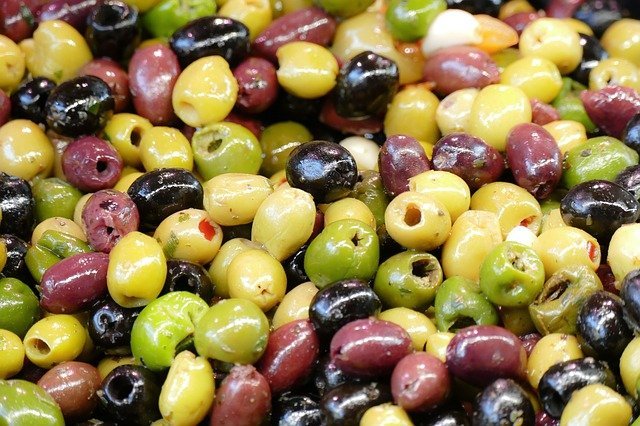
Very rich in antioxidants, olives are very healthy and versatile foods in the kitchen, especially in the Mediterranean tradition. Let’s see what are the nutritional properties and benefits of olives.
Olives are the fruits of the olive tree (Olea europaea), a plant belonging to the Oleaceae family. These are small fruits, characterized by an internal stone. The olives can be consumed directly, after specific treatment, or used for the production of oil, whose characteristics will depend on those of the olives of origin.
Olives cannot be eaten fresh, because they are very bitter due to the high content of polyphenols. It is therefore necessary to subject them to procedures, such as immersion in water, to reduce their content of bitter substances. First of all, however, let’s see what are the nutritional properties of olives.
Olives: calories and nutritional values
Olives are quite caloric fruits and range from about 140 calories of green olives to 235 calories of black olives, every 100 grams of edible part. The high quantity of calories is justified by the presence of a certain amount of fats, among which we find monounsaturated fatty acids (the main one is oleic acid) and, to a lesser extent, polyunsaturated fatty acids (especially linoleic acid). They also contain a fair amount of fiber (greater in green olives than black ones) and a good amount of water. In the table below, we deepen the nutritional values of olives.
Nutritional values per 100g of green olives:
- Kilocalories: 142
- Waterfall: 76.8 gr
- Carbohydrates: 1 gr
- Proteins: 0.8 gr
- Fat: 15.0 gr
- Of which saturated: 2.1 gr
- Fibers: 4.4 gr
- Soccer: 64 mg
- Iron: 1.6 mg
- Zinc: 0.40 mg
- Phosphorus: 14 mg
- Potassium: 432 mg
- Vitamin B1 or thiamine: 0.03 mg
- Vitamin B2 or riboflavin: 0.08 mg
- Vitamin B3 or niacin: 0.50 mg
- Oleic acid: 10.32 gr
- Linoleic acid: 1.58 gr
- Beta-carotene: 288 µg
- Vitamin E: 1.99 mg
- Glycemic index: 15
Olives: nutritional properties
In olives, as we have mentioned, we find a good amount of fiber, potassium and above all vitamins such as vitamin E and important antioxidants such as beta-carotene, lutein and zeaxanthin. Furthermore, in olives there is a substance that has a strong antioxidant and antitumor action, called hydroxytyrosol. Let’s see the main characteristics of these substances.
- Vitamin E: this vitamin exerts an antioxidant action, therefore it protects against oxidative damage caused by free radicals. Vitamin E is deposited in the superficial layers of the skin, protecting it from UV rays, pollution and smoke. It prevents the onset of coronary heart disease and fights male infertility. Olives contain 1.99 mg of vitamin E per 100 grams;
- Beta-carotene: the quantity of beta-carotene present in olives is 288 µg. beta-carotene is an antioxidant, precursor of vitamin A, which protects the skin and sight and intervenes in the processes of cell growth and differentiation. Beta-carotene is a plant pigment responsible for the orange color of plants;
- Lutein and zeaxanthin: these are 2 carotenoids present inside the retina, inside which they perform a strong protection against damage caused by light radiations, thanks to their antioxidant action;
- Hydroxytyrosol: it is a polyphenol that has a strong antioxidant and antitumor properties. It is also very present in the leaves of the olive tree and in the vegetation water, later finding it in various concentrations also in the olive oil.
Olives: health benefits
Olives, as well as olive oil, are typical ingredients of the Mediterranean diet and their consumption brings numerous health benefits. In particular, the presence of antioxidants and good fats gives olives useful properties to support the health of the cardiovascular system and reduce the damage caused by free radicals, but not only. Let’s see all the benefits of olives.
✓ Antioxidant and anticancer properties
As we have seen, olives are very rich in antioxidants such as vitamin E, beta-carotene, hydroxytyrosol, lutein and zeaxanthin. All these antioxidants protect our body from damage caused by free radicals, therefore they counteract cellular aging and the formation of cancerous cells. Furthermore, a study showed how the consumption of olive waste water was able to increase the levels of glutathione, an antioxidant naturally present in the body. Another research has instead shown that hydroxytyrosol induces apoptosis in human colon cancer cells.
✓ Regulate intestinal motility
Olives are rich in fibers, which stimulate the sense of satiety and promote intestinal motility, also helping the elimination of waste and toxins. In addition, the fibers reduce the absorption of fats and sugars.
✓ Lower bad cholesterol levels
Olives, if consumed with a certain consistency, help to reduce cholesterol levels, in particular the so-called “bad” cholesterol. Research published many years ago tested the effect of olive oil supplementation (50g per day) in the diets of 10 healthy male subjects, over a 2-week period. The result was a 16% lowering of LDL cholesterol levels. This means that the consumption of olives and the respective oil protects against the onset of cardiovascular diseases.
✓ Protect the sight
Olives protect the eyes and visual function thanks to the content of beta-carotene, a precursor of vitamin A, essential for sight, and thanks to the presence of lutein and zeaxanthin, two antioxidants present in the retina.
✓ Reduce blood pressure
A study conducted on rats showed that the aqueous-methanolic extract of olive is able to reduce blood pressure values. This activity would be due to the presence of monounsaturated fatty acids such as oleic acid.
✓ They are suitable for diabetics
Olives have a low glycemic index, so they can be consumed, in moderate quantities, even by those suffering from diabetes. In addition, the presence of fiber helps to reduce the glycemic levels of the meal.
Differences between green olives and black olives
The difference between green olives and black olives lies mainly in the ripeness. Green olives, in fact, owe their color to the presence of chlorophyll and have not yet undergone a complete ripening. Black olives, on the other hand, have reached the complete ripening cycle and their color is due to the development of anthocyanins.
Nutritionally, green and black olives are quite similar, with one major difference in the amount of fat and protein. Specifically, black olives are richer in proteins (with a value of 1.6 gr / 100 gr) and contain a greater quantity of oleic acid (17.27 gr / 100 gr) and linoleic acid (2.65 gr / 100gr). Finally, as we mentioned at the beginning of the article, we remind you that black olives contain less fiber than green olives (2.4 gr against the 4.4 gr of green olives).
How many olives to eat per day?
In order not to introduce too many kilocalories in the diet, it is recommended not to exceed the dose of 7-8 green olives per day, which provide about 50 kilocalories.
Olives: some tips for use
Olives are endowed with extreme versatility in the kitchen. They can be added to salads or used to flavor a sauce for pasta. Olives can be used to season meat and fish, but they can also be added to pizza or chopped to flavor meatballs or to form a cream to spread on bread.
If you want to try to pick olives from trees and prepare them at home, it is necessary to undergo some treatments before being consumed. In particular, to remove the bitterness from fresh olives, a valid method is immersion in water. It is necessary to place the olives in a container with a lid and cover them with water, immersing them completely. The water must be changed twice a day for at least 15 days. Once the bitterness has been removed, you can proceed with salting, using successive brines made with water and a different percentage of salt, first at 8%, then at 10% and finally at 6% of salt.
Olives: Contraindications and Potential Negative Effects
Olives should not be consumed by those allergic to these fruits. Children can consume olives, being careful to remove the inner core first, which could cause suffocation. In case of hypertension, beware of excessive use of olives preserved in salt as they can bring an excess of sodium.






